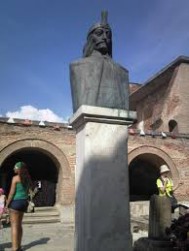Dracula- myth, legend and truth
DRACULA- MYTH-LEGEND AND TRUTH
The character of Dracula, as perceived in his day, appears as an interference between the many legends that have circulated over time between Irish novel Bram Stoker and the real historical facts of Prince Vlad Tepes, also called Draculea.
Lord Vlad the Impaler is an emblematic image, being the subject of many literary and historical creations. Vlad Tepes is mentioned for the first time in history in 1448, when it begins but ends its first reign. In 1456, Vlad Tepes climbed for the second time on the Throne of the Romanian Country until 1462. There followed a tumultuous event, during which Vlad Tepes struggled against the Ottoman Empire, the hatred of this people starting from childhood , it was when he was taken hostage by the Turks, and his family had been killed by them.
We all wonder, perhaps, where the name of the prince Vlad Tepes comes from and where the association with Dracula comes from. The nickname "Tepes" was attributed to him by his authoritarian rule, trying to impose honor and diligence as values of the Roman people. The thieves and the cunning were severely punished, those who disregarded the ruler's rules being pulled up. Although he was described as a cruel and intolerant man, Vlad Tepes was respected by his subjects for his effective campaigns against the Turks.
The association with Dracula comes from the name of Vlad the Impaler's father, who carries the Dracula surnames and hence a series of derivations such as Dracea, Dracula, Draculea, etc. Vlad Tepes's father was a member of the Order of the Dragon, a struggle against the heretics and unbelievers.Thus, the Dracula / Dracula's surnames attributed to Vlad Tepes, as well as the character created by Bram Stoker in the novel "Dracula", led to the association and confusion of the prince Vlad Tepes with the legendary character Dracula. In Stoker's novel, Dracula is a Count of Transylvania, a centuries-old vampire active, the master of a castle located somewhere in the Carpathian Mountains, the description of which perfectly matches that of Bran Castle.
It seems that he had an impeccable reputation among the vampires because he would have studied the Black Magic at an academy near the city of Sibiu (Hermannstadt).
Can we talk about Vlad Tepes and Dracula as one and the same character? Well, no! Dracula is a fictional character and it is desirable that everyone distinguish between the historical character Vlad Tepes and the imaginary Dracula character, created by Bram Stoker in the 1897 novel with the same name.
Bram Stoker had the intention of making a character split from the Irish stories. During his research for the novel, he has come to tell him about Transylvania - a mountainous area, far away and with a bloody history, which led him to change the initial name of the place where the action took place and to establish the character's castle in Transylvania.In the description of Dracula's Castle, Bram Stoker has as its starting point a presentation of Bran Castle, available in England of the nineteenth century, this being the only castle in Transylvania, which is why Dracula was associated with the Bran Castle.
First of all, it seems that Prince Vlad Tepes had a connection with Bran Castle. The nearest road to Wallachia was through Bran, the closest passage to Brasov, which, in turn, secured connection with Targoviste, the seat of Vlad Tepes. The customs where the tolls were collected on this road were at the foot of the Bran Castle, but there was no clear document stating whether Vlad Tepes had conquered Bran Castle or not. However, at the end of 1462, Vlad Tepes was captured by Matei Corvin and imprisoned for 2 months in Bran Castle.
Count Dracula in Bram Stoker's novel is a centuries-old vampire born from the myth that in the villages near Bran there is belief in the undead, people living the day who suffer from the curse of immortality and who haunts the villagers at night , because the spirit leaves their body.
So, although there is a tendency to make a connection between the historical character of Vlad Tepes and the fictitious character Dracula, or even to confuse him, we must distinguish between the two, between reality and myth.
For a tour where you can see places full of history, where you can better understand the Dracula myth you see here.


